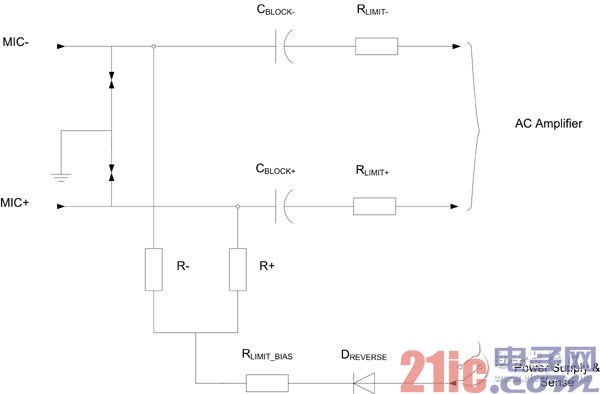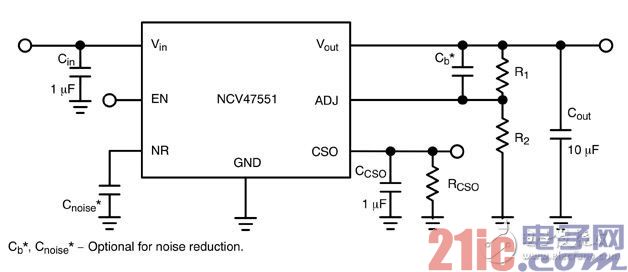Car microphone bias and fault detection
Car buyers are increasingly demanding more advanced car infotainment systems with higher levels of functionality and higher quality audio, and they are beginning to expect lower noise levels in the car. As a result, more and more common electronics engineers specify microphones in their system designs, so that car passengers can have a better user experience while traveling.
This article refers to the address: http://
Typically, there are two types of in-vehicle applications that require microphones—voice detection and active noise reduction (ANC).
1. Voice Detection – Voice streaming to your phone requires this feature. It is usually carried over Bluetooth wireless synchronous transmission.
2. ANC – for road noise reduction (RNC) and engine level noise reduction (EOC) to reduce road and engine/exhaust noise, respectively. This feature is implemented using advanced digital signal processing (DSP) algorithms and amplifier and load speaker outputs of the infotainment system to produce amplified anti-phase noise. Today, the application of ANC technology to RNC and EOC for internal combustion engine vehicles is increasing dramatically.
While voice transmission tends to use a single (omnidirectional or unidirectional) microphone, the three-dimensional ANC relies primarily on multiple error microphones located in different parts of the interior of the cabin. Critical to these applications is the extremely low noise offset. In addition, because they are located outside of the infotainment system, effective fault detection is also required in both cases.
Key microphone power requirements
Normally, the current consumed by a car microphone is relatively low, depending on the microphone impedance and the type of integrated amplifier stage. A typical unidirectional microphone can consume as little as 0.5 mA, while an omnidirectional beamforming microphone can consume 20 mA. Depending on the required signal-to-noise ratio (SNR) and the type of integrated amplifier, the supply voltage may vary from 1.0 V to 15.0 V, but most supply voltage levels range from 5.0 V to 8.0 V. Offset microphone input lines require a specified power supply with low noise and low power supply rejection ratio (PSRR), especially in the human ear. This requirement requires a low noise linear regulator.
The location of the microphone away from the infotainment system also complicates the situation. Externally located loads present the risk of incorrect connections during assembly and maintenance. Therefore, the microphone power supply needs to be able to detect the wrong connection and protect itself.
Principle of microphone power
The integrated microphone regulator provides an attractive alternative to discrete or high-side switches and offers ample work advantages. The built-in current mirror makes it possible to detect the microphone and diagnose fault conditions in the load – this is especially important during car assembly and maintenance, as there may be problems with the infotainment system, the microphone or the cable between them or assembly errors during this time. risks of. Therefore, there is a possibility that the microphone regulator output (VOUT) is short-circuited to the ground, open circuit, or short-circuited to the battery with a low probability.
Microphone regulator advantage
A typical discrete diagnostic and protection circuit can contain up to 20 discrete components, involving high assembly costs, complex failure modes and effects analysis, and the consumption of valuable microcontroller resources to perform command and control functions. In contrast, the integrated microphone regulator is a single IC that requires only a small number of external small signal components. In addition, the integrated solution carefully controls technical parameters such as current-limit accuracy and current mirrors, making it easier to develop fault strategies, fault detection thresholds, and worst-case analysis. The programmable output current and current limit levels and IC enable functions are controlled by a microphone regulator to achieve flexibility in the circuit programming capabilities inherent in discrete circuit designs. Provides accurate and adjustable output voltage regulation, including well-defined loop stability limits, indicating that the fully protected output can be set to the target output voltage associated with the microphone input requirements, coupled with a low-cost standard equivalent series A stable loop of the resistance (ESR) output capacitor.

Figure 1: Example of a discrete microphone bias circuit (without detection or troubleshooting)
AC Amplifier: AC Amplifier
Power Supply & Sense: Power and Sensing Application Examples
Figure 2 shows an example of a microphone regulator with standard application settings. The device used in the figure is the new NCV47551 from ON Semiconductor, which has an adjustable output voltage that can be set to an output voltage between 3.3 V and 20 V using an external resistor divider. Mirror current obtained from the regulator current sense output (CSO) pin - this current to load current ratio is fixed (usually 1:1) - can be monitored as a fixed resistor to ground voltage (VCSO ), and can be sampled using an analog-to-digital converter (ADC). The resistor value RCSO also sets the current limit threshold level. By monitoring the CSO voltage, current mirrors can be used to separate roads, shorts to ground, and normal operating conditions.

Figure 2: Application circuit diagram of a microphone regulator using ON Semiconductor NCV47551
Optional for noise: optional component to reduce noise
Since the microphone load current is usually so low, the current mirror ratio needs to be set to a value that does not cause an open circuit detection problem. In an open event, the CSO current will drop to its lowest value. But it needs to be kept high enough to ensure that the ADC input capacitor is charged within its sample and hold time constant range. Although the ADC itself is a load on the CSO pin, since the CSO pin incorporates current-limit and current-monitoring functions, this load may affect the current-limit value if the sense current level threshold is too low. Therefore, in the case where the mirror current ratio is 1:1, the external buffer can be omitted.
By monitoring the VCSO value, the ADC can be used to detect various fault conditions. In the short-circuit condition of VOUT to ground, the load impedance drops to 0, or close to 0, causing the load current to rise and trigger the externally set current limit, and the output voltage is proportional to the reverse. This causes the VCSO to rise instantaneously to its upper limit. The second protection provided is the use of a second default current limit set to an internal fixed value with a faster loop response than the preset current limit to ensure current limiting at startup. There is a further protection that uses a thermal limit threshold detected by a thermal sensing device (TSD) adjacent to the regulator's linear bypass element to ensure that the maximum junction temperature is not exceeded. If this threshold is exceeded, the regulator will shut itself down until it returns to its original state.
If an open load condition occurs, the load current will drop to zero or very close to zero. Accordingly, the VCSO will drop to near ground potential while ICSO ensures that it is not above the level sufficient to charge the input capacitance of most ADCs to meet sampling and maintenance requirements. Although it is not possible to directly identify a short-circuit condition to the battery using the VCSO input, the device is protected in the short-circuit condition of VOUT for the battery, whether it is powered or not. If necessary, an external circuit can be added to detect a short circuit to the battery.
Another important consideration is the suppression of noise. The high DC gain provides a power-supply rejection ratio (PSRR) that minimizes the regulator's output noise and is also bypassed, providing a second high-frequency, low-impedance channel to shunt high-frequency current and further reduce output noise. To this end, an external ceramic bypass capacitor CNOISE was used.
NCV47551 is designed for use in automobiles. Its enable and input pins can withstand ISO 16750-2 load dump pulses up to 45 V peak without external polarity reversal protection. In addition, the NCV47551 is specifically designed to provide a low-noise power supply that ensures the ADC's compatibility in detecting possible fault conditions in the microphone.
in conclusion
A new generation of current sense regulator ICs provides a simple, integrated solution that powers most types of external microphones in automotive audio and infotainment applications. They are able to monitor load conditions and thus provide extremely efficient troubleshooting. They also provide protection in the event of an important fault condition.

Pay attention to ON Semiconductor's official WeChat to learn more innovative and energy-efficient solutions
Pin Header Connector,Pin Header Female,Male Header Pins,Right Angle Pin Header
Cixi Xinke Electronic Technology Co., Ltd. , https://www.cxxinke.com